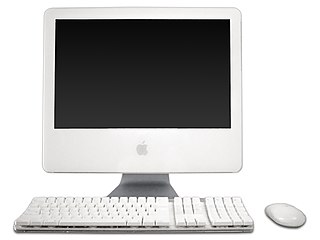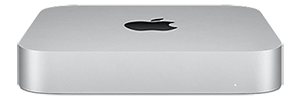
macOS, originally Mac OS X, previously shortened as OS X, is an operating system developed and marketed by Apple since 2001. It is the primary operating system for Apple's Mac computers. Within the market of desktop and laptop computers, it is the second most widely used desktop OS, after Microsoft Windows and ahead of all Linux distributions, including ChromeOS.

Safari is a web browser developed by Apple. It is built into Apple's operating systems, including macOS, iOS, iPadOS and visionOS, and uses Apple's open-source browser engine WebKit, which was derived from KHTML.

iMovie is a free video editing application made by Apple for the Mac, the iPhone, and the iPad. It includes a range of video effects and tools like color correction and image stabilization, but is designed to be accessible to users with little or no video editing experience. iMovie's professional equivalent is Apple's Final Cut Pro X.

iLife is a discontinued software suite for macOS and iOS developed by Apple Inc. It consists of various programs for media creation, organization, editing and publishing. At various times, it included: iTunes, iMovie, iPhoto, iDVD, iWeb, and GarageBand. Only iMovie and GarageBand remain and are now freely available on Apple's Mac App Store. iDVD and iWeb have been discontinued while iTunes and iPhoto have been succeeded by Music and Photos respectively.
In Apple's Macintosh operating systems, labels are a type of seven distinct colored and named parameters of metadata that can be attributed to items in the filesystem. Labels were introduced in Macintosh System 7, released in 1991, and they were an improvement of the ability to colorize items in earlier versions of the Finder. Labels remained a feature of the Macintosh operating system through the end of Mac OS 9 in late 2001, but they were omitted from Mac OS X versions 10.0 to 10.2, before being reintroduced in version 10.3 in 2003, though not without criticism. During the short time period when Mac OS X lacked labels, third-party software replicated the feature.

Aqua is the graphical user interface, design language and visual theme of Apple's macOS and iOS operating systems. It was originally based on the theme of water, with droplet-like components and a liberal use of reflection effects and translucency. Its goal is to "incorporate color, depth, translucence, and complex textures into a visually appealing interface" in macOS applications. At its introduction, Steve Jobs noted that "... it's liquid, one of the design goals was when you saw it you wanted to lick it".

Mac OS X 10.0 is the first major release of macOS, Apple's desktop and server operating system. It was released on March 24, 2001, for a price of $129 after a public beta.

Mac OS X Public Beta was the first publicly available version of Apple Computer's Mac OS X operating system to feature the Aqua user interface. It was released to the public on September 13, 2000 for US$ 29.95. Its release was significant as the first publicly available evidence of Apple's ability to ship the "next-generation Mac operating system" after the Copland failure. It allowed software developers and early adopters to test a preview of the upcoming operating system and develop software for it before its final release. It is the only public version of Mac OS X to have a code name not based on a big cat until the release of 10.9 Mavericks in 2013. The US version had a build number of 1H39 and the international version had build number 2E14.

The iMac G5 is a series of all-in-one personal computers that was designed, manufactured and sold by Apple Computer from 2004 to 2006. The iMac G5 returned to a more traditional design after the "sunflower" iMac G4, with the computer components fitted behind a liquid-crystal display and mounted on an aluminum foot. The computer was designed around the need to cool its PowerPC 970 processor, and features an interior divided into zones for cooler, quieter operation.

Automator is an application developed by Apple Inc. for macOS, which can be used to automate repetitive tasks through point-and-click or drag and drop.
The Apple community consists of the users, media, and third party companies interested in Apple Inc. and its products. They discuss rumors, future products, news stories, and support of Apple's products. Apple has a devoted following, especially for the Apple II, Mac, iPod, iPhone, and luminary staff members. The personal computer revolution, mixed with Apple's vertical integration of its products and services, has increased popularity. Apple's corporate policy of extreme secrecy about future products intensify interest in the company's activities.

Unsanity was a macOS shareware software developer founded in May 2000, notable for coining the term "haxie". Unsanity produced Mac utilities that relied on their own Application Enhancer, a utility that modified the system and other applications. Software incompatibility with Mac OS X Leopard, Snow Leopard, and Lion ended Unsanity's offerings.

Toast is an optical disc authoring and media conversion software application for macOS. Its name is a play on the word burn, a term used for the writing of information onto a disc through the use of a laser.

The iTunes media platform was first released by Apple in 2001 as a simple music player for Mac computers. Over time, iTunes developed into a sophisticated multimedia content manager, hardware synchronization manager and e-commerce platform. iTunes was finally discontinued for new Mac computers in 2019, but is still available and supported for Macs running older operating systems and for Windows computers to ensure updated compatibility for syncing with new releases of iOS devices.

Mac, short for Macintosh, is a family of personal computers designed and marketed by Apple. The name Macintosh is a reference to a type of apple called McIntosh. The product lineup includes the MacBook Air and MacBook Pro laptops, and the iMac, Mac Mini, Mac Studio, and Mac Pro desktops. Macs are sold with the macOS operating system; the latest release is macOS 15 Sequoia.

Mac Mini is a small form factor desktop computer developed and marketed by Apple Inc. As of 2022, it is positioned between the consumer all-in-one iMac and the professional Mac Studio and Mac Pro as one of four current Mac desktop computers. Since launch, it has shipped without a display, keyboard, and mouse. The machine was initially branded as "BYODKM" as a strategic pitch to encourage users to switch from Windows and Linux computers.

OS X Mountain Lion is the ninth major release of macOS, Apple Inc.'s desktop and server operating system for Macintosh computers. OS X Mountain Lion was released on July 25, 2012, for purchase and download through the Mac App Store, as part of a switch to releasing OS X versions online and every year, rather than every two years. Named to signify its status as a refinement of the previous OS X version, Lion, Apple's stated aims in developing Mountain Lion were to allow users to more easily manage and synchronise content between multiple Apple devices and to make the operating system more familiar.

OS X Mavericks is the 10th major release of macOS, Apple Inc.'s desktop and server operating system for Macintosh computers. OS X Mavericks was announced on June 10, 2013, at WWDC 2013, and was released on October 22, 2013, worldwide.

macOS Sierra is the thirteenth major release of macOS, Apple Inc.'s desktop and server operating system for Macintosh computers. The name "macOS" stems from the intention to unify the operating system's name with that of iOS, watchOS and tvOS. Sierra is named after the Sierra Nevada mountain range in California and Nevada. Specifically, Lone Pine Peak is the location for macOS Sierra's default wallpaper. Its major new features concern Continuity, iCloud, and windowing, as well as support for Apple Pay and Siri.

The iMac Pro is an all-in-one personal computer and workstation sold by Apple Inc. from 2017 to 2022. At its release, it was one of four desktop computers in the Macintosh lineup, sitting above the consumer range Mac Mini and iMac, and serving as an all-in-one alternative to the Mac Pro. After the cylindrical Mac Pro redesign went years without any update, Apple hosted a roundtable with journalists promising a redesign and commitment to professional Mac computers; the iMac Pro was introduced in the interim before the revised Mac Pro shipped in 2019.

















